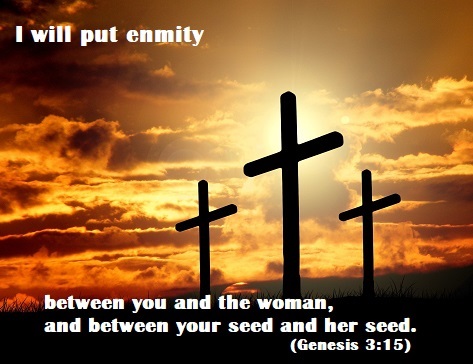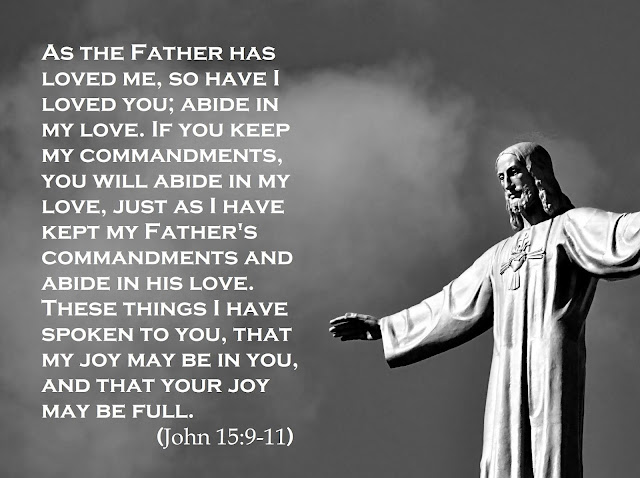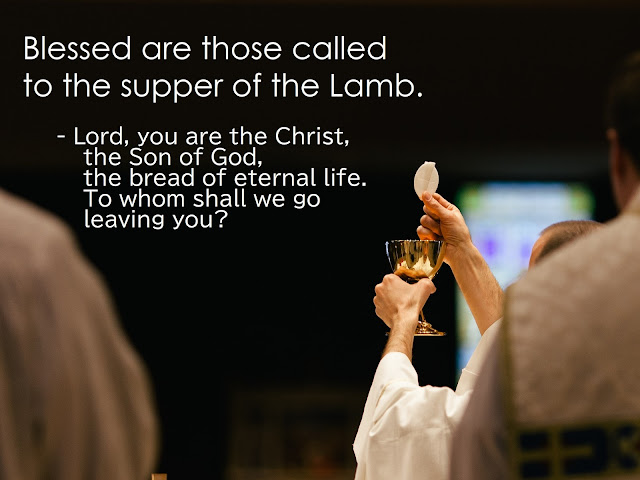The Estuary of Theology 14
I Will Put Enmity
The discussion in the previous issue shows that even though the “my church” (cf. Matthew 16:18, The Estuary of Theology issue 8), which has the role and the vocation of the Holy Family, had bruised the head of the serpent, its effect has been postponed as the result of the fulfilment of God’s foretelling, “[Y]ou shall bruise his heel” (cf. Genesis 3:15). Therefore, the fulfilment of this foretelling is supposed to have happened after the “my church” was established through Pentecost. In this case, “his heel” indicates the heel of the “my church,” which was established by the Holy Spirit, who makes Jesus’ spirit present, while “you” indicates the information of the “serpent,” which has been existing since the man had become two persons, the man and the woman (cf. The Estuary of theology issue 11).
In this issue I would like to discuss again the work of the information of the “serpent,” which makes people like Satan (the devil) (cf. The Estuary of Theology issue 12), forms the “head of the serpent” (cf. The Estuary of Theology issue 13), confronts the “my church,” and makes the “my church” unable to appear in public, by examining the whole foretelling of God: “I will put enmity between you and the woman, and between your seed and her seed; he shall bruise your head, and you shall bruise his heel” (Genesis 3:15). The information of the “serpent” is the product of the accidental emergence of information, which occurs within the memory of the five-sense data of living things, including humans, when more than two of them gather together (cf. The Estuary of Theology issue 11).
Each of the following information expressed in the dialogue between the “serpent” and the woman is the accidental information (the information of the “serpent”) which emerged in the memory of the five-sense data: “Did God say, ‘You shall not eat of any tree of the garden’?” (Genesis 3:1); “We may eat of the fruit of the trees of the garden; but God said, ‘You shall not eat of the fruit of the tree which is in the midst of the garden, neither shall you touch it, lest you die.’” (Genesis 3:2-3). We can understand that this information was shared by the man and the woman because the woman says, “We.”
The woman, whom God newly created out of one of the ribs of the man, looked at God just after her awakening, and then she was taken to the man (cf. Genesis 2:22). At the moment, the woman, who was created as a helper, perceived the difference between God and the man, and the accidental information (the information of the “serpent”) which explains this difference as that of intelligence emerged in the memory of her five-sense data. Therefore, the word of the “serpent,” “You will not die. For God knows that when you eat of it your eyes will be opened, and you will be like God, knowing good and evil” (Genesis 3:4-5), was the accidental information (the information of the “serpent”) which emerged only in the woman’s five-sense data. This information gave her an image: “that the tree was good for food, and that it was a delight to the eyes, and that the tree was to be desired to make one wise” (Genesis 3:6). Also from this fact, we can understand that the accidental information (the information of the “serpent”) which emerges in human five-sense data is very intelligent and wise.
At that time, the accidental information (the information of the “serpent”), “You will not die,” was in the memory of the five-sense data of the woman, who did not know death, and was memorized in her knowledge of good and evil which was connected with her memory of the five-sense data as a strong recognition because death did not happen even after eating the fruit of the tree of the knowledge of good and evil, and she never came to know death. This memory was handed down by her to people. People have come to have the firm recognition, “You will not die,” at every moment of living and to live everyday life in this recognition. On the other hand, Jesus lived accepting God’s plan, “[Y]ou shall die,” seriously at every moment of living. Then he was suffered, died, descended into hell and resurrected on the third day. This very Jesus was the God who could say the word, “[You] shall never die,” as the word of truth. Only Jesus could say, “I am the resurrection and the life; he who believes in me, though he die, yet shall he live, and whoever lives and believes in me shall never die. Do you believe this?” (John 11:25-26).
The following word of God was his plan: “You may freely eat of every tree of the garden; but of the tree of the knowledge of good and evil you shall not eat, for in the day that you eat of it you shall die” (Genesis 2:16-17). God puts his commands in the five-sense data of living things so that all of them may live following the plan of God. In this way, living things, which have neither free mind nor knowledge, can live following the word of God. The first man, who had his free mind but did not have knowledge, was also like this. However, the knowledge of good and evil, which the man came to have by eating from the tree of the knowledge of good and evil after he became the man and the woman, was connected with their memory of the five-sense data and tried to take in God’s command put in it and to make it their own knowledge. However, nobody can know the plan of God even if his /her knowledge of good and evil memorises this command of God because in order to know it he/she needs someone who preaches good news about the kingdom of God and the name of Jesus Christ (cf. The Act of the Apostles 8:12). The episode of Philip and the Ethiopian eunuch in the Act of the Apostles tells that the angel of the Lord and the Spirit encouraged Philip to open his mouth for the eunuch, who was reading the prophet Isaiah in his chariot, and he told him the good news of Jesus beginning with this scripture (cf. The Act of the Apostles 8:26-35).
The woman took this plan of God, which was put in her memory of her five-sense data, into her memory of the knowledge of good and evil. However, at that time, there was no one who preached good news about the kingdom of God and the name of Jesus Christ for her, and she never learned the meaning of the plan of God even though she took in it. As a result, the word of God, “[Y]ou shall die,” was put in her memory of the knowledge of good and evil as a word of God that contradicts her recognition: “You will not die.” Then she ended up having a contradiction (cf. The Estuary of Theology issue 13).
In this situation, the woman answered in confusion, “The serpent beguiled me, and I ate” (Genesis 3:13), when God asked her, “What is this that you have done?” (Genesis 3:13). The woman is supposed to have said, “The serpent beguiled me,” unconsciously at the moment because the image of the accidental information (the information of the “serpent”), which had been continuously emerging in her memory of the five-sense data, was similar to the move of a serpent, a creature creeping on the earth. In this way, the woman, who experienced a contradiction for the first time as a human being, made up the imaginary state of “The serpent beguiled me” to escape from the contradiction without intention.
So, God called the accidental information (the information of the “serpent”), which the woman had called “the serpent” because of ignorance, “you” personifying it, saying, “I will put enmity between you and the woman, and between your seed and her seed.” As Jesus said, “For to him who has will more be given, and he will have abundance; but from him who has not, even what he has will be taken away. This is why I speak to them in parables, because seeing they do not see, and hearing they do not hear, nor do they understand” (Matthew 13:12-13), God, at that time, left the woman, who was holding contradiction within her knowledge of good and evil and putting herself in the imaginary state to hide the contradiction, ignorant.
God put “enmity” between the accidental information (the information of the “serpent”) and the woman so that all people, who were to have contradiction thanks to the first created woman, may dissolve the contradiction, which they had as the result of their taking the accidental information (the information of the “serpent”) into their knowledge of good and evil, by the “enmity” God put. When one dissolves the contradiction by him/herself in this way, he/she will be able to acknowledge that he/she was holding it, and then he/she will know the necessity of mastering the accidental information (the information of the “serpent”) before holding the contradiction.
God added the function of dissolving contradiction to the knowledge of good and evil by his word, “I will put enmity.” When God created the woman out of one of the ribs of the man in the garden of Eden, the womb which was suitable for a human being, who had the free mind and knowledge unlike other living things, was already completed. Man’s knowledge of good and evil begins to develop even in his/her mother’s womb. Therefore, the function of “enmity” added to the knowledge of good and evil later has become a heavy burden to the womb which conceives the child with this function. So, God foretold the woman, “I will greatly multiply your pain in childbearing; in pain you shall bring forth children” (Genesis 3:16).
On the other hand, when the man ate the fruit of the tree of the knowledge of good and evil which was handed by the woman, his knowledge of good and evil, which he had gained by eating the fruit, was connected with his five-sense data, and he quickly took in the accidental information (the information of the “serpent”). Then, his knowledge of good and evil found the data, “My wife gave me the fruit from the tree” in his memory of the five-sense data, and he said, “The woman whom thou gavest to be with me, she gave me fruit of the tree, and I ate” (Genesis 3:12), taking the cause of his act of "having eaten it" to be the result of the act of his wife. Nevertheless, even though the man ate the fruit because the woman gave it to him, his act contradicted the word of God which forbade him to eat it. So, he attributed the cause of the contradiction to God’s act and justified the memory of his act which was in his five-sense data saying, “The woman whom thou gavest to be with me....”
Cain was the first man whose function of “enmity,” which God had put to dissolve the contradiction, worked. When he committed the murder and was asked by God about it, he replied, “I do not know; am I my brother's keeper?” (Genesis 4:9), like his father, who had replied, “The woman whom thou gavest to be with me, she gave me fruit of the tree, and I ate.” He tried to attribute the cause of the murder he had committed to the act of the one who had had no regard for his offering and to justify his own act (cf. The Estuary of Theology issue 13). However, after God asked him, “What have you done?” he did not make up an imaginary state like his mother, to whom God had given the same question, did. He answered, “My punishment is greater than I can bear” (Genesis 4:13). He dissolved the contradiction by himself by the “enmity,” which God had put between him, who was the seed of the woman, and the contradiction, which was the seed of the “serpent,” and recognized he had committed the sin.
When people direct the “enmity,” God put, to the contradiction, they will realize that there is no connection between God’s manner (God’s plan) and the accidental information (the information of the “serpent”). When people try to master the accidental information (the information of the “serpent”) as they master all other living things following God’s command faithfully (cf. Genesis 1:28), their knowledge of good and evil will be awaking to the fact that God’s plan is the only goodness one should memorize as knowledge. For this very purpose, God created the knowledge of good and evil for the human free mind. The knowledge of good and evil is the knowledge that memorizes the fact that only God’s plan, namely God’s manner, is good, and that anything else is evil and directs the human free mind towards the Holy Spirit, the only goodness itself in this world, and urges the human free mind to follow the spirit of Jesus.
God arranged that people, when holding a contradiction, do not block it out hiding it from him/herself, making an imaginary state and escaping into it or do not attribute the cause of the contradiction to others and justify the memory of his/her act in his/her five-sense data but dissolve it by the “enmity,” which God put, and recognize what he/she did as his/her own. The “enmity” that God put encourages people to acknowledge that he/she took the accidental information (the information of the “serpent”) into his/her knowledge of good and evil and acted making him/herself like Satan (the devil) (cf. The Estuary of Theology issue 12) and to have the courage to take responsibility for the sin they committed. God desired people to distinguish the accidental information (the information of the “serpent”), which is the root of the sin, and to master it taking responsibility for it (cf. The Estuary of Theology issue 12). For this purpose, God added the “enmity” to the function of the knowledge of good and evil.
Considering the discussion above, it is clear that Jesus described in the Gospel concretely and faithfully lived the word of God: “I will put enmity … between your seed and her seed.” Jesus, who had nothing to do with contradiction as a man, saw outside himself a lot of people who opposed him because of the contradiction caused by having taken in the accidental information (the information of the “serpent”). He confronted the contradiction, which parasitized people and made them like Satan (the devil), with “enmity.” In this way the following prophecy of Simeon was fulfilled on Jesus and his mother: “Behold, this child is set for the fall and rising of many in Israel, and for a sign that is spoken against (and a sword will pierce through your own soul also), that thoughts out of many hearts may be revealed” (Luke 2:34-35).
Jesus in his Passion and death on the cross was the “enmity” itself, which God had put in Genesis to dissolve the contradiction. As three Synoptic Gospels write (cf. Matthew 27:32, Mark 15:21, Luke 23:26), the narrative in which the soldiers forced Simon, a man of Cyrene, to carry Jesus’ cross makes us associate it with the word of Cain: “My punishment is greater than I can bear.” Cain, who committed the murder, prophesized the punishment that he was to receive saying, “Behold, thou hast driven me this day away from the ground; and from thy face I shall be hidden; and I shall be a fugitive and a wanderer on the earth, and whoever finds me will slay me” (Genesis 4:14). However, God absolved him, who had acknowledged his sin solving his contradiction by the “enmity” God had put. God planned to achieve the atonement for all people by bearing the punishment, which Cain had prophesized, instead of him and by becoming a man, suffering, dying, descending into hell, and by resurrecting (cf. The Estuary of Theology issue 13).
The dialogue between Jesus and the two criminals, who were crucified on the right and the left of him (cf. Luke 23:39-43), proves the very existence of Jesus has become the “enmity” God had put. When one of the criminals said, “Are you not the Christ? Save yourself and us!” the other was able to say to him, “Do you not fear God, since you are under the same sentence of condemnation? And we indeed justly; for we are receiving the due reward of our deeds; but this man has done nothing wrong.” This was because he dissolved his contradiction by the presence of Jesus, who had become the “enmity” itself which God had put on the cross. When he said, “Jesus, remember me when you come into your kingdom,” Jesus replied, “Truly, I say to you, today you will be with me in Paradise.” The criminal, who railed at Jesus, could not but become silent hearing this dialogue, and he must have reformed himself too. Jesus, at that moment, fulfilled the word which he had told to Nicodemus before: “And as Moses lifted up the serpent in the wilderness, so must the Son of man be lifted up, that whoever believes in him may have eternal life. For God so loved the world that he gave his only Son, that whoever believes in him should not perish but have eternal life” (John 3:14-16).
God put the “enmity” between the contradiction, the seed of the “serpent,” and the seed of the woman to dissolve the contradiction the human knowledge of good and evil holds so that Jesus atones for the sins of all people. Jesus, the God who knows the will of the Father perfectly, fully used the “enmity” God had put and fulfilled the will of the heavenly Father. Furthermore, he placed the Eucharist in the “my church” by constituting the Eucharist. The Eucharist, the presence of God, because it is the body of Jesus, succeeds the “enmity,” which is for dissolving the contradiction. When Christians who take and eat the Eucharist face the Eucharist, the “enmity,” which God put, and which the Eucharist succeeded, works to dissolve their contradiction. Christians who accept this work of the Eucharist and realize that they had the contradiction and committed a sin to hide the fact of having the contradiction cannot help saying to God, “My punishment is greater than I can bear,” as Cain did. For the sake of these Christians, risen Jesus breathed on the Apostles and gave them the authority of forgiving sins saying, “Receive the Holy Spirit. If you forgive the sins of any, they are forgiven” (John 20:22-23). The word which Jesus added next, “if you retain the sins of any, they are retained,” tells the reality that if they retain the sins without exercising the authority given by Jesus with the Holy Spirit the sins will remain in front of them without forgiven.
Through Pentecost God’s plan of salvation has fulfilled. On the other hand, the foretelling of God, “[Y]ou shall bruise his heel,” has fulfilled by the work of the information of the “serpent.” It is a contradiction that these two realities are co-existing. According to the discussion in this issue, we should be able to dissolve this contradiction by the “enmity,” which God has put. From the next issue, I would like to develop our discussion keeping this fact in mind.
To be continued.
May 2020 in Hiroshima
Maria K





Comments
Post a Comment